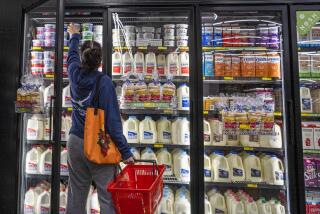Producer Prices Do About-Face, Fall 0.1% in First Decline Since ’87
- Share via
WASHINGTON — Wholesale prices abruptly reversed an 18-month upward march in June and unexpectedly fell 0.1%, impelled by steep declines in food and energy prices, the Labor Department said Friday.
The slowdown in inflation for finished goods, though welcome after a big 0.9% spurt in May, provoked mixed feelings in economists. Some noted that the producer prices for items other than food and energy still jumped ahead 0.7%, the largest such advance in nearly three years. Others discounted that number as distorted by unusual increases for tobacco and certain capital goods.
In general, the inflationary trend moderated sharply in the second quarter, with wholesale prices rising at an annual rate of 5.1% from April through June--exactly half the 10.2% annual inflation rate from January through March. Excluding food and energy, wholesale price inflation advanced at an annual rate of 5.5% in the first quarter and 4.4% in the quarter that ended last month.
Future Moderation Suggested
During the first six months of 1989, producer prices have risen at an annual rate of 7.6%, while the increase excluding food and energy has been at a rate of 4.9%.
In addition, prices for intermediate goods and crude materials, which had been rising dramatically so far this year, also turned downward by 0.2% and 2.0% respectively, a strong suggestion of future moderation for finished goods.
Meanwhile in separate reports on economic performance last month, the Commerce Department said retail sales declined a relatively steep 0.4% and the Federal Reserve reported a 0.2% decline for industrial production and a 0.3% drop in the rate of capacity utilization in the nation’s factories, utilities, oil wells and mines. All three reports showed declines for the second consecutive month in each category, and all three added to accumulating evidence that the economy is slowing rapidly.
David Wyss, of the Data Resources research firm in Lexington, Mass., was skeptical that the 0.1% decline in the producer price index was other than a statistical blip that, while impressive on a bar graph, was probably misleading.
“The increase of 0.7% excluding food and energy is worrisome,” he said. “It’s the biggest increase in this measure of the core rate of inflation since October, 1986, and we haven’t seen any bigger increase since 1980.”
On the other hand, Wyss said the decline in retail sales, paced by continuing weakness in sales of autos and other big-ticket durable goods, reflected a welcome caution on the part of consumers who, he said, have been spending too much and saving too little for most of the past six years.
“The Fed seems to be on target to a gradual slowdown,” he said, “but the inflation problem leaves the Fed in a quandary. They are worried about recession, and the drop in sales and the decline in production increase that risk. But can they really afford to loosen interest rates with inflation running high?”
Worrisome Rate So Far
Georgia State University’s Donald Ratajczak said, “Inflation at the producer level is definitely falling off,” adding that the economic forecasting project he directs, which specializes in price movements, now projects that wholesale prices for finished goods will increase about 4% during 1989, despite ringing up a worrisome 7.6% annual rate so far.
Wholesale food prices, up 5.4% over the past 12 months and rising at a 13.5% annual rate in the first quarter, thanks to last year’s drought, have now definitely moderated.
Ratajczak noted that food was down 2.3% from April through June and down 0.8% in June alone. Likewise, energy prices at wholesale--up 16.3% over the past 12 months and soaring at an annual rate of nearly 36% this year--dropped in June by 3.1%. Ratajczak expressed confidence that energy prices have peaked and will stabilize for the foreseeable future.
More to Read
Inside the business of entertainment
The Wide Shot brings you news, analysis and insights on everything from streaming wars to production — and what it all means for the future.
You may occasionally receive promotional content from the Los Angeles Times.









